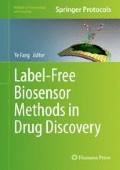Abstract
The oblique-incidence reflectivity difference (OIRD) method is a novel optical biosensor which has recently been applied to label-free, real-time detection of molecular interactions in microarray format using a functionalized glass substrate. The capability of the OIRD to independently monitor association and dissociation kinetics enables real-time profiling of ligand–receptor interactions. The microarray format of the OIRD method makes it a practical platform for high-throughput, system-wide affinity profiling of the interactions of proteins, DNA, or whole cells with a diverse set of biomolecules.
Access this chapter
Tax calculation will be finalised at checkout
Purchases are for personal use only
References
Zhu H, Snyder M (2003) Protein chip technology. Curr Opin Chem Biol 7(1):55–63. doi:10.1016/S1367-5931(02)00005-4
Heller MJ (2002) DNA microarray technology: devices, systems, and applications. Annu Rev Biomed Eng 4(1):129–153. doi:10.1146/annurev.bioeng.4.020702.153438
Templin MF, Stoll D, Schrenk M, Traub PC, Vöhringer CF, Joos TO (2002) Protein microarray technology. Drug Discov Today 7(15):815–822. doi:10.1016/S1359-6446(00)01910-2
Schulman SG, Sharma A (1999) Introduction to fluorescence spectroscopy. Wiley, New York
Green R, Davies J, Davies M, Roberts C, Tendler S (1997) Surface plasmon resonance for real time in situ analysis of protein adsorption to polymer surfaces. Biomaterials 18(5):405–413
Abdiche Y, Malashock D, Pinkerton A, Pons J (2008) Determining kinetics and affinities of protein interactions using a parallel real-time label-free biosensor, the Octet. Anal Biochem 377(2):209–217. doi:10.1016/j.ab.2008.03.035
Hu S, Wan J, Su Y, Song Q, Zeng Y, Nguyen HN, Shin J, Cox E, Rho HS, Woodard C (2013) DNA methylation presents distinct binding sites for human transcription factors. Elife 2:e00726. doi:10.7554/eLife.00726
Landry JP, Fei Y, Zhu X (2012) Simultaneous measurement of 10,000 protein-ligand affinity constants using microarray-based kinetic constant assays. Assay Drug Dev Technol 10(3):250–259. doi:10.1089/adt.2011.0406
Liu S, Zhu J, He L, Dai J, Lu H, Wu L, Jin K, Yang G, Zhu H (2014) Label-free, real-time detection of the dynamic processes of protein degradation using oblique-incidence reflectivity difference method. Appl Phys Lett 104(16):163701. doi:10.1063/1.4873676
Lu H, Wen J, Wang X, Yuan K, Li W, Lu H, Zhou Y, Jin K, Ruan K, Yang G (2010) Detection of the specific binding on protein microarrays by oblique-incidence reflectivity difference method. J Optic 12(9):095301. doi:10.1088/2040-8978/12/9/095301
Sun Y-S, Landry JP, Fei Y, Zhu X, Luo J, Wang X, Lam K (2008) Effect of Fluorescently Labeling Protein Probes on Kinetics of Protein-Ligand Reactions. Langmuir 24(23):13399–13405. doi:10.1021/la802097z
Xu W, Heng L, Juan W, Kun Y, Hui-Bin L, Kui-Juan J, Yue-Liang Z, Guo-Zhen Y (2010) Label-free and high-throughput detection of protein microarrays by oblique-incidence reflectivity difference method. Chin Phys Lett 27(10):107801
Chen F, Lu H, Chen Z, Zhao T, Yang G (2001) Optical real-time monitoring of the laser molecular-beam epitaxial growth of perovskite oxide thin films by an oblique-incidence reflectance-difference technique. J Opt Soc Am B 18(7):1031–1035. doi:10.1364/JOSAB.19.001218
Zhu X-D (2004) Oblique-incidence optical reflectivity difference from a rough film of crystalline material. Phys Rev B 69(11):115407. doi:10.1103/PhysRevB.69.115407
Chen F, Lu H, Zhao T, K-j J, Chen Z, Yang G-Z (2000) Real-time optical monitoring of the heteroepitaxy of oxides by an oblique-incidence reflectance difference technique. Phys Rev B 61(15):10404. doi:10.1103/PhysRevB.61.10404
Zhu X-D (2006) Comparison of two optical techniques for label-free detection of biomolecular microarrays on solids. Optic Commun 259(2):751–753. doi:10.1016/j.optcom.2005.09.079
Bradley A, Cai WW (2000) Chemically modified nucleic acids and methods for coupling nucleic acids to solid support. Google Patents, Patent CA2326684C.
Gershon D (2002) Microarray technology: an array of opportunities. Nature 416(6883):885–891. doi:10.1038/416885a
Hu S-H, Xie Z, Blackshaw S, Qian J, Zhu H (2011) Characterization of protein–DNA interactions using protein microarrays. Cold Spring Harbor Protocols 2011 (5). doi:10.1101/pdb.prot5614
Langmuir I (1918) The adsorption of gases on plane surfaces of glass, mica and platinum. J Am Chem Soc 40(9):1361–1403
Myszka DG (2000) Kinetic, equilibrium, and thermodynamic analysis of macromolecular interactions with BIACORE. Methods Enzymol 323:325–340. doi:10.1016/S0076-6879(00)23372-7
Acknowledgements
S.L. and H.Z. are supported in part by the NIH Common Fund grant U54RR020839.
Author information
Authors and Affiliations
Corresponding authors
Editor information
Editors and Affiliations
Rights and permissions
Copyright information
© 2015 Springer Science+Business Media New York
About this protocol
Cite this protocol
Liu, S., Yang, G., Lu, H., Zhu, H. (2015). Kinetics Characterization of Ligand–Receptor Interactions Using Oblique-Incidence Reflectivity Difference Method. In: Fang, Y. (eds) Label-Free Biosensor Methods in Drug Discovery. Methods in Pharmacology and Toxicology. Humana Press, New York, NY. https://doi.org/10.1007/978-1-4939-2617-6_5
Download citation
DOI: https://doi.org/10.1007/978-1-4939-2617-6_5
Publisher Name: Humana Press, New York, NY
Print ISBN: 978-1-4939-2616-9
Online ISBN: 978-1-4939-2617-6
eBook Packages: Springer Protocols

